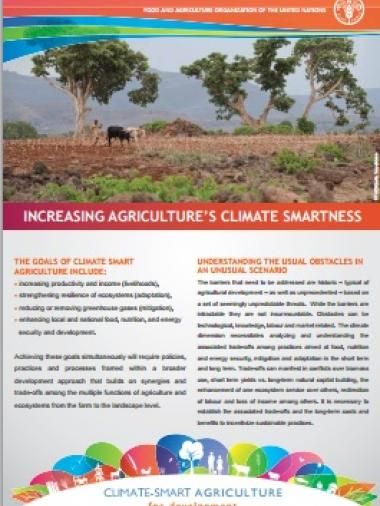Making climate finance work in agriculture

This discussion paper was produced as a background documentfor the 2016 FAO State of Food and Agriculture (SOFA) report. It was produced through desk research and analysis of existing agricultural and climate finance literature. Moreover, qualitative interviews with key experts representing different stakeholder groups in the agriculture, climate, and financial sectors were conducted to inform the potential opportunities and innovations that should be further explored to make climate finance work for agriculture. Finally, a collection of supporting case studies were provided by different stakeholders to showcase some of the most successful and innovative examples already being implemented in the climate finance community.It is important to note that this is a discussion paper that aims to explore the intersection between climate and agriculture finance by generating dialogue. Hence, the paper explores a relatively new field and proposes innovative interventions that either are being tested or could be tested to increase the leverage of private capital and strengthen the links between financial institutions on the one hand and smallholder farmers and SMEs on the other. The objective of the paper is to generate discussion around this topic and, therefore, no blanket recommendations or descriptive interventions are proposed. A growing population and changing diets are driving up the demand for food. Production is struggling to keep up as crop yields level off in many parts of the world, ocean health declines, and natural resources— including soils, water and biodiversity—are stretched dangerously thin. Climate change is critically interrelated with agriculture. On the one hand, agriculture is extremely vulnerable to climate change. This paper proposes three different avenues to use climate finance to achieve this goal: a) Designing and adapting innovative mechanisms to leverage additional sources of capital, from both public and private sources, that can be directed towards climate smartinvestments in the agriculture sector. b) Identifying entry points for directing climate finance into agriculture and for linking FIs to smallholders and agricultural SMEs, including through capacity building and technical assistance. c) Providing technical assistance to increase investments in agriculture. Finally, this paper presents several suggestions to contribute to the achievement of the ideas presented in this paper, including the need for increased knowledge on innovative financial instruments and mechanisms, bridging information gaps, identifying opportunities, promoting dialogue and cooperation, and designing an action plan to move this agenda forward.
Citation
Sadler MP; Millan Arredondo A, Swann SA, Vasileiou I, Baedeker T, Parizat R, Germer LA, Mikulcak F. 2016. Making climate finance work in agriculture. Washington DC, United States of America: World Bank Group.